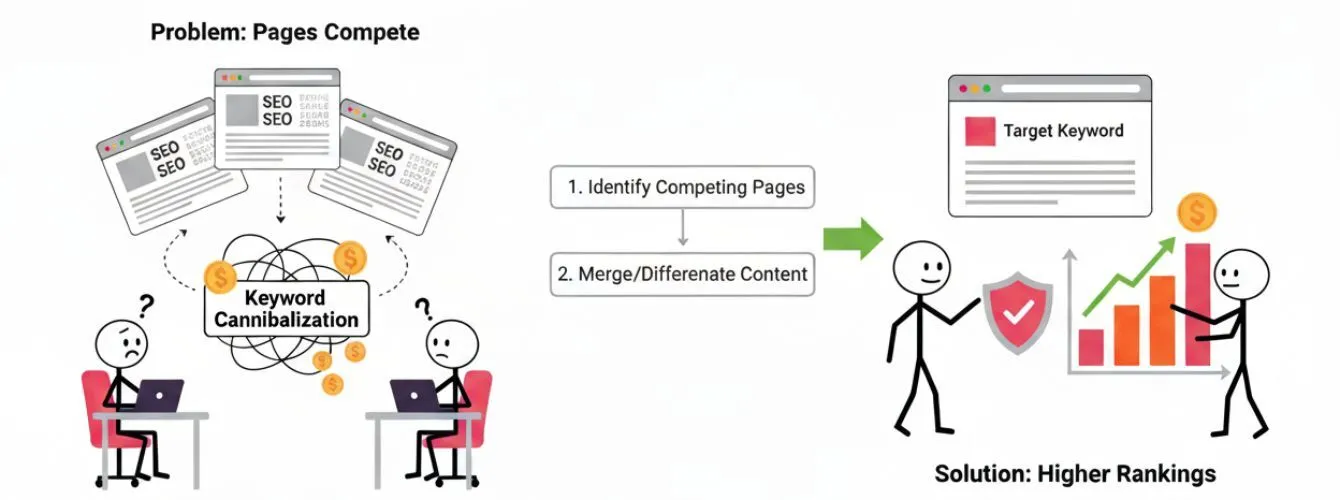Did you know that 63% of businesses find it challenging to generate traffic and leads through SEO despite dedicating substantial time and resources to their efforts? This statistic underscores a common issue: many companies are investing in SEO but not seeing the desired results. Understanding the common pitfalls in SEO strategies is crucial to improving performance and maximizing ROI.
This blog will highlight why SEO strategies fail and provide actionable insights to address these issues. By recognizing and addressing these common mistakes, you can refine your approach and achieve better outcomes for your SEO campaigns.
Thinking Tactically Instead of Strategically
One of the primary reasons SEO strategies fail is the focus on tactical actions rather than strategic planning. Tactical actions are short-term, individual tasks such as keyword optimization, making some backlinks, or creating content to fill the space. These tasks are often executed without considering the broader, long-term goals of the business.
Strategic planning, on the other hand, involves developing a cohesive, long-term approach that aligns with the overall business objectives. This includes understanding the target audience, setting clear goals, and creating a roadmap integrating various SEO elements like on-page optimization, off-page strategies, technical SEO, and content marketing.
Lack of Audience Demand
Meeting the user’s intent and creating content around it is most important. When you create content or target keywords that align with what users are actively searching for, you increase the likelihood of attracting relevant traffic and engagement. Conversely, if you focus on keywords or topics that need more demand, your efforts will likely result in low traffic and minimal engagement.
To avoid these issues, it’s essential to conduct thorough keyword research and audience analysis. Use tools like Google Keyword Planner, Ahrefs, or SEMrush to identify keywords with significant search volume and relevance to your audience. Understand your target audience’s demographics, preferences, and pain points. Use tools like Google Analytics and social media insights to gather data.
Overlooking the Technical Side of SEO
Ignoring the technical aspects of SEO can severely hinder your website’s performance and ranking potential. Optimizing your website’s infrastructure to ensure it is accessible, functional, and efficient for both users and search engines.
Technical SEO forms the backbone of your website’s health and performance. It ensures that search engines can easily crawl and index your site, leading to better visibility in search results.
Broken links and missing pages create a poor user experience and negatively impact your rankings. Duplicate content can confuse search engines and dilute your ranking power. Ensure each page has unique content and use canonical tags to address duplication issues. Misconfigured robots.txt files or meta tags can prevent search engines from indexing important pages, limiting your site’s visibility.
You should audit your website using Google Search Console, Screaming Frog, and SEMrush to identify and rectify issues that could harm its performance.
UX Issues
After the 2021 Google’s core update, user experience (UX) is a critical factor in SEO, encompassing various elements such as site speed, mobile-friendliness, and navigation. Good UX ensures visitors have a seamless and enjoyable experience on your website, which can positively impact your SEO efforts. Regular UX audits and improvements are essential to provide a positive user experience. This can involve:
- Site Speed Optimization: Use tools like Google PageSpeed Insights to identify and fix issues that slow down your site.
- Mobile-Friendliness: Ensure your site is responsive and provides a good device experience.
- Navigation: Make sure your site is easy to navigate, with clear menus and a logical structure.
By prioritizing UX, you can reduce bounce rates, increase dwell time, and improve your site’s overall SEO performance. Regularly updating and optimizing your site’s UX will help maintain a positive user experience and support your SEO goals.
Not Paying Attention to How Google Rank
Monitoring keyword rankings and SERP (Search Engine Results Page) positions is crucial for understanding the effectiveness of your SEO efforts. With this insight, you can optimize your strategy and improve your search visibility.
You must track ranking performance to ensure you get opportunities. You should optimize high-potential keywords that could drive significant traffic. Without regular monitoring, you won’t know if your current strategies are still effective or need adjustments, as Search engine algorithms frequently change.
Tracking and analyzing keyword rankings is recommended. Tools like Google Search Console and third-party SEO software such as Ahrefs, SEMrush, and Moz can provide valuable insights into your keyword performance and help you make data-driven decisions. Regularly monitoring your rankings allows you to identify trends, spot issues early, and adjust your strategies to maintain or improve your search visibility.
Outdated Practices
SEO is changing what worked a few years ago, but it might not be effective today. Some outdated SEO practices include:
- Keyword Stuffing: Focusing on covering the keywords in content without giving helpful information can lead to penalties from search engines.
- Link Farms: Building backlink profiles from networks of low-quality websites can harm your site’s reputation and result in penalties.
- Ignoring Mobile Optimization: With the increasing use of mobile devices, failing to optimize your site for mobile can negatively impact user experience and rankings.
Stay updated with the latest content trends and algorithm changes. Focus on high-quality, user-centric content that provides value to your audience. Use keywords naturally and in context, ensuring they align with the content’s intent. Earn backlinks from reputable, relevant sites rather than engaging in link schemes.
Lack of Time and Funds
A common issue is abandoning SEO efforts prematurely when results aren’t immediately visible. SEO is a long-term strategy that often takes months to show significant results. Quitting too early can negate progress and waste prior investments, leading to missed opportunities for growth.
SEO is a complex and ongoing process that often requires access to premium tools, continuous content creation, technical optimization, and expert assistance. When businesses underfund their SEO efforts, they face limitations. If you are doing SEO on your own, it’s better to hire a skilled SEO agency, which can be less costly and drive results early.
Encourage a long-term commitment to SEO, continuous optimization, and regular performance reviews. Track gradual improvements, adjust strategies as needed, and remain patient. Consistent effort and investment over time are key to achieving and maintaining strong SEO performance.
Conclusion
Understanding why your SEO strategy isn’t working is the first step towards improvement. You can significantly enhance your SEO performance by identifying and addressing common pitfalls such as audience demand, technical SEO, ignoring user experience, failing to monitor rankings, using outdated practices, and avoiding the roadmap. Remember, SEO is a long-term commitment that requires continuous optimization, regular audits, and updating the latest trends. Adopting a strategic, user-focused approach and maintaining patience can improve your search rankings and overall online presence. Keep refining your strategy, invest wisely, and your efforts will pay off over time.








